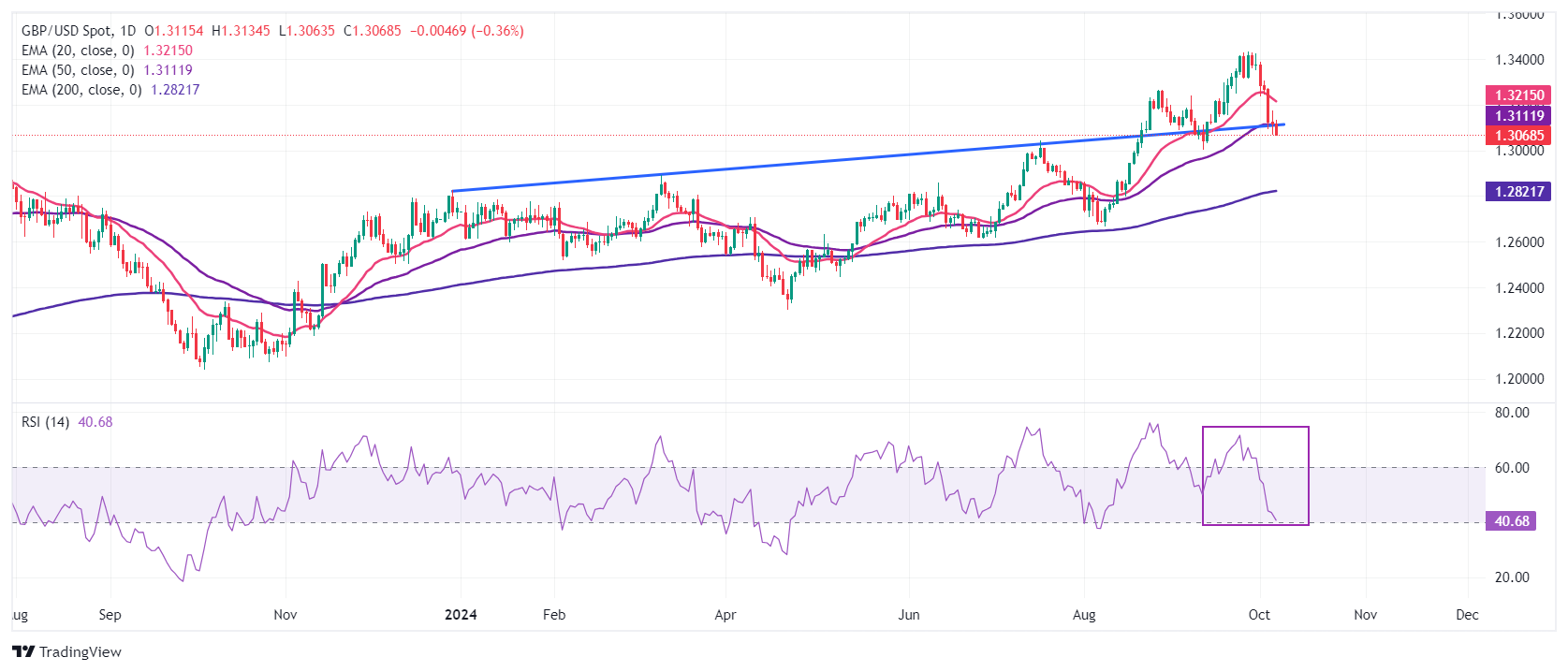- The Pound Sterling falls sharply below 1.3100 against the US Dollar as traders pare Fed large rate cut bets.
- US NFP report for September showed a sharp uptick in payrolls and wage growth.
- Growing Middle East tensions weigh heavily on risk-sensitive assets.
The Pound Sterling (GBP) weakens and slips below 1.3100 against the US Dollar (USD) in Monday’s North American session. The GBP/USD pair faces a sharp sell-off as the US Dollar holds gains to near an almost seven-week high, driven by robust growth in the United States (US) Nonfarm Payrolls (NFP) for September, released on Friday. The US Dollar Index (DXY), which tracks the Greenback’s value against six major currencies, extends its winning streak for the sixth trading day on Monday to near 102.50.
All components of the US labor market report for September pointed to a resilient economy. Fresh payrolls came in at 254K, the highest level seen since March, and the Unemployment Rate dropped to 4.1%. Average Hourly Earnings, a key measure of wage growth that drives consumer spending, rose at a robust pace of 4% year-over-year.
Surprisingly upbeat labor market data forced traders to unwind bets supporting a Federal Reserve’s (Fed) larger-than-usual rate cut of 50 basis points (bps) in November. According to the CME FedWatch tool, the Fed's probability of reducing interest rates by 50 bps has been entirely wiped out, and a quarter-to-a-percentage rate cut is now widely anticipated.
On Friday, Chicago Fed Bank President Austan Goolsbee called the latest US employment report "superb". He added, "If we get more reports like this, I'm going to feel a lot more confident that we are, in fact, settling in at full employment," Reuters reported.
Going forward, investors will focus on the US Consumer Price Index (CPI) data for September, which will be published on Thursday. The inflation data will provide more clarity about the Fed’s likely interest rate action in November.
Daily digest market movers: Pound Sterling declines on Bailey supports aggressive rate cuts if inflation eases further
- The Pound Sterling weakens against its major peers at the start of the week. The British currency faces pressure on dismal market sentiment due to growing tensions between Iran and Israel in the Middle East region. Israel intensified strikes across Beirut and its southern suburbs on Sunday after Israeli Prime Minister Benjamin Netanyahu vowed to win.
- Ongoing tensions in the Middle East region have deepened risks of Oil supply chain reduction, which have resulted in a sharp upside in energy prices. This could lead to a higher foreign outflow from Oil-importing economies.
- Apart from the cautious market mood, rising expectations of the Bank of England (BoE) to cut interest rates again in November have also weighed on the Pound Sterling. Last week, the comments from BoE’s Governor Andrew Bailey in an interview with the Guardian newspaper indicated that the central bank could be a bit more aggressive in its approach to lower interest rates if inflationary pressures continue to decline.
- On the contrary, BoE Chief Economist Huw Pill advised cutting interest rates gradually in his speech at the Institute of Chartered Accountants in England and Wales on Friday. Pill said, "While further cuts in Bank Rate remain in prospect should the economic and inflation outlook evolve broadly as expected, it will be important to guard against the risk of cutting rates either too far or too fast.”
- This week, the major trigger for the Pound Sterling will be the monthly Gross Domestic Product (GDP) and the factory data for August, which will be released on Friday.
Technical Analysis: Pound Sterling breaks below trendline support
The Pound Sterling trades inside Friday’s trading range, with investors focusing on the US CPI data for September. The GBP/USD pair is expected to remain on the backfoot as it struggles to hold the 50-day Exponential Moving Average (EMA), which trades around 1.3110. The Cable is at make or a break near the upward-sloping trendline from the 28 December 2023 high of 1.2827.
The 14-day Relative Strength Index (RSI) declines inside the 40.00-60.00 range, suggesting a loss of bullish momentum. However, the upside trend remains intact.
Looking up, the 20-day EMA near 1.3234 will be a major barricade for the Pound Sterling bulls. On the downside, the pair would find support near the psychological figure of 1.3000.
Information on these pages contains forward-looking statements that involve risks and uncertainties. Markets and instruments profiled on this page are for informational purposes only and should not in any way come across as a recommendation to buy or sell in these assets. You should do your own thorough research before making any investment decisions. FXStreet does not in any way guarantee that this information is free from mistakes, errors, or material misstatements. It also does not guarantee that this information is of a timely nature. Investing in Open Markets involves a great deal of risk, including the loss of all or a portion of your investment, as well as emotional distress. All risks, losses and costs associated with investing, including total loss of principal, are your responsibility. The views and opinions expressed in this article are those of the authors and do not necessarily reflect the official policy or position of FXStreet nor its advertisers. The author will not be held responsible for information that is found at the end of links posted on this page.
If not otherwise explicitly mentioned in the body of the article, at the time of writing, the author has no position in any stock mentioned in this article and no business relationship with any company mentioned. The author has not received compensation for writing this article, other than from FXStreet.
FXStreet and the author do not provide personalized recommendations. The author makes no representations as to the accuracy, completeness, or suitability of this information. FXStreet and the author will not be liable for any errors, omissions or any losses, injuries or damages arising from this information and its display or use. Errors and omissions excepted.
The author and FXStreet are not registered investment advisors and nothing in this article is intended to be investment advice.
Recommended content
Editors’ Picks

EUR/USD remains offered and challenges 1.0800
The intense recovery in the US Dollar keeps the price action in the risk complex depressed, forcing EUR/USD to recede further and put the key support at 1.0800 to the test on Friday.

GBP/USD breaks below 1.2900 on stronger Dollar
Persistent buying pressure on the Greenback has pushed GBP/USD to multi-day lows below the 1.2900 level, as investors continue to digest the recent interest rate decisions from both the Fed and the BoE.

Gold meets support around the $3,000 mark
The combined impact of a stronger US Dollar, continued profit taking, and the effects of Quadruple Witching weighed on Gold, pulling its troy ounce price down to around the pivotal $3,000 level on Friday.

US SEC Crypto Task Force to host the first-ever roundtable on crypto asset regulation
The US Securities and Exchange Commission (SEC) Crypto Task Force will host a series of roundtables to discuss key areas of interest in regulating crypto assets. The “Spring Sprint Toward Crypto Clarity” series’ first-ever roundtable begins on Friday.

Week ahead – Flash PMIs, US and UK inflation eyed as tariff war rumbles on
US PCE inflation up next, but will consumption data matter more? UK budget and CPI in focus after hawkish BoE decision. Euro turns to flash PMIs for bounce as rally runs out of steam. Inflation numbers out of Tokyo and Australia also on the agenda.

The Best brokers to trade EUR/USD
SPONSORED Discover the top brokers for trading EUR/USD in 2025. Our list features brokers with competitive spreads, fast execution, and powerful platforms. Whether you're a beginner or an expert, find the right partner to navigate the dynamic Forex market.
